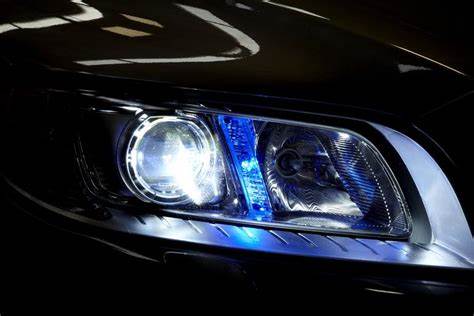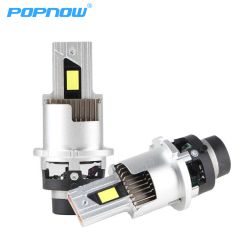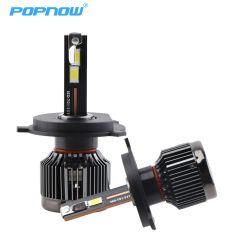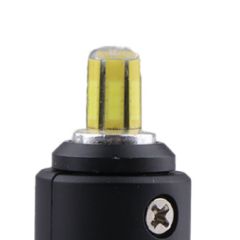No doubt, headlights are one of the most important parts of any vehicle. Therefore, it is essential to choose one of the best options when buying such a product.
At present, LED headlamps are in vogue, and almost every manufacturer is offering these types of headlights in their vehicles.
On the contrary, halogen headlamps are still on the roads, which suggests that they are also popular among drivers.
So which one is the best? To seek the answer to this question, let’s discuss both halogen vs LED headlight bulbs in detail.
How do Halogen Headlights Work?
Halogen headlights have been around for decades and still perform the task efficiently. If you analyze the headlights of many older vehicles, they will turn out to be a halogen lamp. Although the technology is quite old, they are still effective.
They have been refined in such a way that you can still use these bulbs in your car without any issue. The halogen bulb is a type of incandescent light, which uses a tungsten filament and some amount of halogen gas.
The presence of halogen gas makes sure that the evaporated tungsten is re-deposited onto the filament. This is the reason why halogen lamps can last longer. The filament heats up with the passage of current and starts to glow, and this is why halogen light bulbs get so hot when switched on.
As a result, they consume a lot of energy. In fact, most of the energy is utilized in the form of emitting heat.
How do LED Headlights Work?
The principle behind the working of LED headlights is quite different from that of the halogen lamp. As compared to halogens, LEDs work by passing a current through a semi-conductor. When electrons move through the semi-conductor, it tends to emit photons. As a result, light emits from the LED bulb.
LED headlights are relatively more efficient than halogen lamps. Although these lights generate some heat, it is much less than what is produced by halogen lights. LEDs are more reliable, as their operating temperature is kept under control, which enhances their lifespan. This makes LED headlights more durable than their halogen counterparts.
Advantages and Disadvantages of Halogen Headlights
As stated earlier, halogens have been serving their purpose well for a long time. The reason behind the popularity of these headlight lamps is quite simple. These bulbs are easy to replace and cheap too.
When it comes to availability, you can find halogen bulbs in any auto store. Moreover, if you can perform regular maintenance of your car, changing a halogen lamp won’t be a difficult task.
However, there are some disadvantages too. Halogen lamps offer only 800 operating hours on average. This is because they are sensitive and less durable. Halogen lamps consume a lot of energy, which renders them as the less eco-friendly option.
Advantages and Disadvantages of LED Headlights
At present, LEDs are much more popular among manufacturers, as they fit their vehicles with LED headlights and taillights. They provide a sleek and modern look to the vehicle. LED lights are unobtrusive and small in size, giving room for designers to make trendier headlights.
LEDs are more preferred than halogen headlights as they require less energy. Hence, by switching to LED headlamps, you can play your role in terms of energy conservation. Moreover, LEDs are durable and can last up to 10,000 hours.
This suggests you don’t have to worry about the performance and efficiency of your LED headlights. Since the temperature is regulated with the heat sinks and fans, you won’t face overheating issues.
In addition, these lights can last longer than halogen bulbs. Depending on the size of the headlight housing, you can choose between a variety of LED lights. This allows you to enhance the light of your vehicle without changing its headlight housing.
Apart from these benefits, LED lamps aren’t immune to drawbacks. For instance, these lights are difficult to fit in conventionally designed headlight housings. Although LED headlights don’t create much heat, they do generate some heat.
The presence of a heat sink and fan reduces the amount of heat emitted. The chip located in the emitter board emits a lot of heat, which may stop to function properly if the LED gets overheated. Moreover, you may also face some problems with the assembly and connecting cables.
The provision of heat sinks and fans makes these LED lamps huge. Therefore, these lights require more space when fitting in the headlight housings. By introducing the required technology, the overall cost of the LED headlights can increase drastically.
That’s the reason which makes LED lights more expensive than halogen lamps. With the availability of limited space within the engine bay, it might not be possible to fit any kind of LED headlight within your car. Moreover, it is relatively difficult to change your LED headlight without any technical assistance.
Conclusion
While concluding the above discussion, one can ascertain that technological advancement does have its benefits. LED headlights have a longer lifespan and offer much brighter light. The light emitted through a halogen lamp is yellowish in color, while LEDs offer a whiter light.
However, these benefits have their own price to pay. LED lamps are more expensive than conventional halogen lamps. This is the reason people prefer replacing halogens when changing faulty headlight lamps.
Although the manufacturers of LED headlights have tried to keep the installation process simple, it is still complex. In contrast, replacing a halogen lamp is simple and hassle-free.
Also, local laws of some states don’t allow the use of LEDs due to some safety reasons. The light emitted by LED headlights is far brighter than halogen lamps. This makes it hard for oncoming drivers to see the road. As a result, car owners prefer to use halogen bulbs instead of HID or LED bulbs.
To conclude, the decision to buy LED or halogen headlights depends on your own preference and your make and model of vehicle. Therefore, you need to analyze your needs and budget when opting for any of these headlight bulbs.






